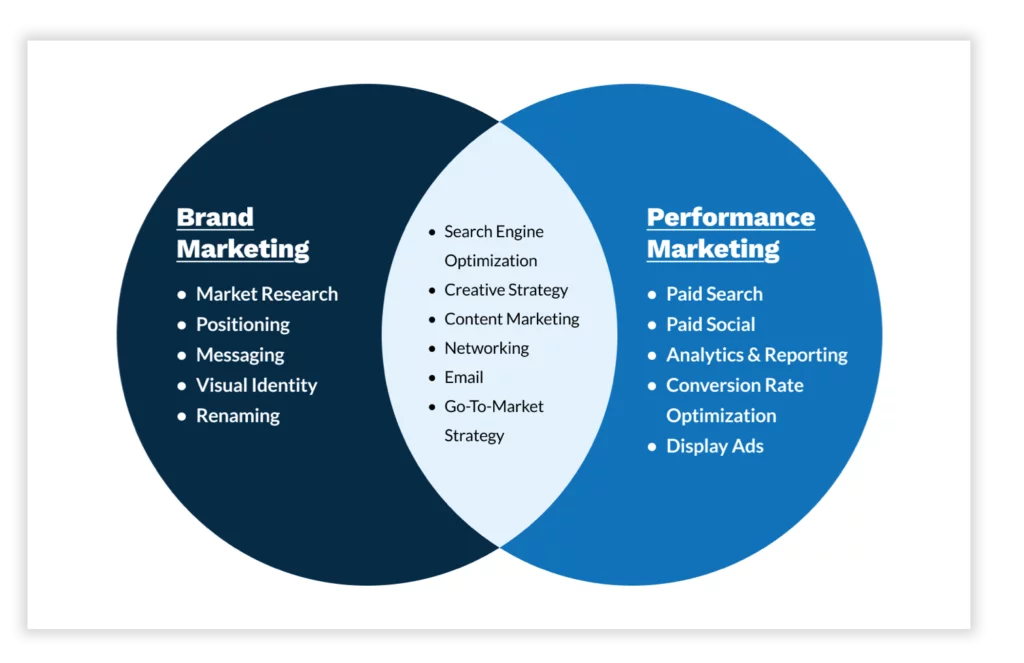
I spent the first seven years of my career at a branding agency. Now I do marketing at a performance agency. There is a big difference between brand vs performance marketing. You need both for a successful strategy. But what are the differences? What are the synergies? How do you communicate this internally?
Let’s find out.
What is brand marketing?
Your company’s brand is a product of its reputation and visibility. It’s why you’re in business, what you’re known for, and how well your target buyers recall your name. It’s hard to quantify. Justifying investments of time and budget can be difficult, but a critical part of your strategy.
Brand marketing positions your company for specific audiences. Market research uncovers what your buyers care about. Then, brand marketing applies those learnings to marketing messages and visual identity.
What is performance marketing?
Performance marketing generates attributable revenue. The CMO can report to the CEO on metrics like return on ad spend broken down by source channel. Behind it all is a complex operation that generates awareness, drives website traffic, and converts users into paying customers. It can be highly technical, but also a major growth lever.
Brand vs performance marketing
A strong brand can have a major impact on performance. On the flip side, performance marketing can bring visibility to smaller brands. Some marketing activities are clearly marked as either branding or performance. Others overlap. This intersection is critical because these activities serve both brand and performance.

For example, web pages that demonstrate thought leadership are often used in Editorial SEO. But they won’t perform well if the content isn’t relevant to real buyer challenges. On the other hand, content may be relevant, but if the page takes too long to load, Google may not index it, making it invisible to search engines.
Both brand and performance are critical parts of a marketing strategy. They’re intertwined. Marketers must find the right balance in the resources they devote to each and how their teams are structured. But first, they must be measured properly.
How to measure brand vs performance marketing
If you can measure it, you can manage it. Analytical metrics can measure the impact of brand vs performance marketing. However, performance is more easy to measure than brand. Below are some examples of common performance and brand marketing metrics.
Example Performance Marketing Metrics
You can calculate the impact of marketing investments in a variety of ways, depending on your marketing org maturity and your analytics setup. Performance marketing metrics often translate into financial terms.
- Cost-per-mille (CPM) — the investment needed to reach 1,000 prospective customers with your message. This can be helpful to measure awareness campaigns.
- Cost-per-click (CPC) — the investment needed, on average, to generate one click. This can be helpful to test and measure the performance between two different pay-per-click (PPC) campaigns.
- Cost-per-acquisition (CPA) — the investment needed, on average, to win one new customer. Over time, this can help measure channel performance and how that contributes to margin and profitability.
- Customer lifetime value (CLTV) — the gross profit a customer delivers to a business throughout their entire time spent as a customer. This can help measure the kinds of customers that you want to go after in the future, and on which channels to find them.
- Return on ad spend (ROAS) — how much revenue is generated per dollar invested in advertisements. This can be helpful to measure the overall performance of your advertising campaigns, and used to forecast revenue.
Example Brand Marketing Metrics
Unlike performance marketing, brand marketing is more difficult to communicate in financial terms. Some brand measurement data is available through digital platforms. Market research is usually the best way to measure brand. Here are some example brand marketing metrics:
- Net Promoter Score (NPS) — an industry-accepted measure of customer loyalty and willingness to recommend a business. Surveys typically collect NPS scores. They are reported with a number between -100 to +100. A higher score is desirable.
- Name Recall — surveys and focus groups can help measure brand strength in a variety of ways. Name recall is a measure of how many customers willingly mention your brand by name when asked about a given product or service category.
- Branded Search — one way to measure brand performance without surveys or focus groups is to monitor the monthly search volume for your brand. It can be a good way to test the performance of TV and radio advertising, too. This was a key part of how we helped AAFMAA transition to a primarily digital marketing operation.
Performance Marketing Strategy
Having the right plan is a major part of performance marketing. Otherwise, you could burn through ad spend without generating the right kinds of leads or sales. After 15 years of helping clients execute on their digital marketing objectives, Silverback Strategies has developed a formula for growth in performance marketing:

1) Align marketing objectives to business goals
A strategic foundation needs to be in place for performance marketing to be effective. First, companies must align their marketing objectives to business goals. If the strategy isn’t right, there’s risk of wasted ad spend and inefficient campaigns.
2) Audience research to inform content & creative strategy
Next, companies need to research their audience to inform content and creative strategy. Ad creative fuels visual ads on Google’s Display Network or paid posts on social media. The creative must resonate with target buyers. If the goal is to generate organic search traffic, your target buyers should actually search for the keywords you target. And when they click, they should have a good experience. These pieces are critical for buyers to see a company as trustworthy and relevant.
3) Targeting and segmentation for message variation
Audience targeting and segmentation is mostly applicable for paid media campaigns, but there are applications for SEO, too. This is the practice of creating groups and subgroups of your audience to target for digital advertisements. In SEO, focus on keywords used by these target buyer profiles.
4) Build out channels, campaigns and ad creative. Launch.
Next, a successful performance marketing strategy considers the right channels and platform tactics to reach your target buyers. Platforms like Google, Facebook, and LinkedIn have different requirements and best practices for ad copy length, image sizes, use of emojis, and more. Beware, though, building out campaigns on these platforms can take a lot of time and energy if you don’t know where to start.
5) Optimize, Test & Scale
Finally, performance marketing needs the right analytics setup to track and measure success. Viewing the right reports and trusting the data is key to making campaign adjustments and communicating with other key organizational stakeholders.
Top Performance Marketing Channels
You should know where your buyers spend time before you select the right channels for your marketing mix. Not all businesses should invest in every performance marketing channel. Here are some common channels to consider:
- Paid Search — this is where companies bid to rank for certain keywords, then pay for each click they receive.
- Organic Search — this is where companies analyze and adjust web pages so they rank higher in natural search results, leading to organic search traffic.
- Paid Social — this is where companies pay to serve ads on social media platforms to audiences that meet certain criteria.
- Programmatic Display — this is where companies load creative ads into a platform like Google Display Network, which are then served to users on various websites
- Email Marketing — this is when users opt-in to receive emails from a company. It’s an opportunity for companies to have more personalized and meaningful conversations.
Performance Marketing Examples
Long Roofing wanted to increase market share in New England. They have expertise in the kind of roofs common in the region, but at the time didn’t have the brand name recognition like they do in the Mid-Atlantic. With a sound go-to market strategy and integrated data across sales, marketing and operations, they saw a path to scaling up revenue and gaining market share. The campaigns were so cohesive, the company was able to predictably scale revenue, or throttle back when leads overwhelmed call centers. This gave Long Roofing the control it needed to meet its business objectives. Ultimately, this led to an in-market revenue increase of 200% year-over-year. Read the full case study.
The online education space is rapidly expanding. eCornell introduces new certificate programs every month to meet this demand. With such rapid production of new website content, eCornell faced a complex challenge of building a proactive approach to search engine optimization (SEO). eCornell challenged Silverback to help drive more organic traffic and enrollments. Technical and strategic SEO improvements increased eCornell’s organic enrollments by 43% year-over-year. Read the full case study.
Brand Marketing Examples
Facebook’s 2021 rebrand is a good recent example of brand marketing. Not only did they change their name to Meta, have a new logo, but they’re investing heavily in virtual reality (their Oculus product) to capitalize on the metaverse. There was likely a heavy investment of time and money spent on Facebook’s rebrand. It’s a critical shift to their evolution.
The Washington NFL franchise recently went through a major rebrand, changing its name to Commanders. Their process included surveys and focus groups of fans, players, and coaches. While the rollout of the new name and jerseys had mixed results from fans (including me), it’s still an interesting case study of a rebrand in a league where team re-names are rare. The most recent example was the Houston Oilers renaming themselves the Titans after relocating to Nashville following the 1998 season.
Balancing brand vs performance marketing
There must be a balance between brand and performance marketing. One can’t exist without the other. Leaning too heavily on brand may not drive the short-term revenue you need. Pushing too far on performance risks your brand becoming stale. They fuel each-other. Striking the right balance can be a major pain point for CMOs, but can lead to predictable, profitable growth.
Ahmad Munawar, founder of Boutique Growth, leveraged a strong personal brand to fuel ads on Facebook, YouTube and LinkedIn. His story is a great example of the symbiotic relationship between brand and performance marketing. I caught up with him on our Digital Marketing Troop podcast where he shared his experience. Listen here:
Work with an award-winning performance marketing team
AdAge, Inc Magazine and the Washington Post have recognized Silverback as one of the top places to work in the United States. After hiring dozens of marketers across the nation in the past few years, Silverback is a premier destination for top digital marketing talent. And better marketing talent means better results for clients.
Our secret is simple. Healthy teams lead to happy employees and happy clients. Silverback’s focus on team health leads to open, honest and direct communication between clients and staff alike. Issues are solved faster, expectations are clear, and the results are impressive.
The way we deliver our services is different, too. Instead of the traditional siloed department structure, we’ve embedded teams of specialists around our clients. We call these teams “Troops.” This model connects marketers across search, social, content and analytics to collaborate together. Teams are led by Senior Marketing Directors that specialize in cross-channel strategy. This combination of platform expertise and strategy consistently outperforms other agencies.
We help marketing leaders drive performance for their brand. Contact us today to learn more.
Recent Posts
Creative Strategy in Digital Advertising
Read the ArticleEthical Considerations of AI In Marketing: Balancing Innovation with Responsibility
Read the ArticleTop-Down vs. Bottom-Up Budgeting: Which Should You Use?
Read the Article
Unlock Your Growth Potential
Silverback helps businesses catapult web traffic, leads, and sales. We combine analytical and creative expertise to drive inbound marketing campaigns and track it all to find insights on what worked, what didn’t, and what we should try out next.
Contact Us